Ningaloo Coast
The Ningaloo Coast is a World Heritage Site located in the north west coastal region of Western Australia. The 705,015-hectare (1,742,130-acre) heritage-listed area is located approximately 1,200 kilometres (750 mi) north of Perth, along the East Indian Ocean. The distinctive Ningaloo Reef that fringes the Ningaloo Coast is 260 kilometres (160 mi) long and is Australia's largest fringing coral reef and the only large reef positioned very close to a landmass.[1][2]
| UNESCO World Heritage Site | |
|---|---|
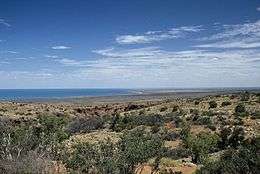 | |
| Location | Western Australia, Australia |
| Criteria | Natural: (vii), (x) |
| Reference | 1369 |
| Inscription | 2011 (35th session) |
| Area | 705,015 ha (1,742,130 acres) |
| Coordinates | 22°33′45″S 113°48′37″E |
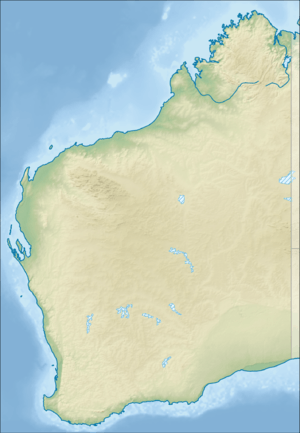 Location of Ningaloo Coast in Western Australia 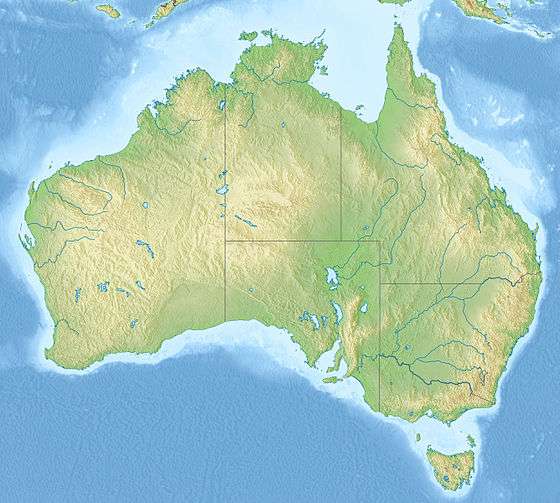 Ningaloo Coast (Australia) | |
The coast and reef draw their name from the Australian Aboriginal Wajarri language word ningaloo meaning "promontory", "deepwater", or "high land jutting into the sea". The Yamatji peoples of the Baiyungu and Yinigudura clans have inhabited the area for over 30,000 years.[3][4]
Ningaloo Coast World Heritage site
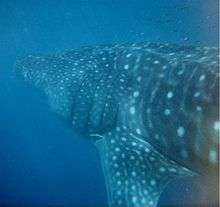
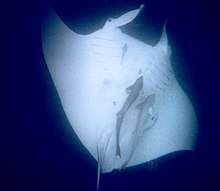
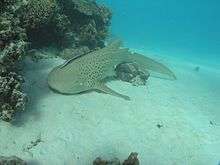
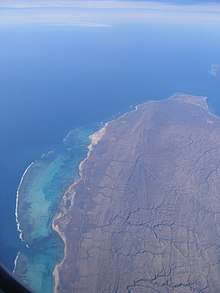
The World Heritage status of the region was created and negotiated in 2011, and the adopted boundary included the Ningaloo Marine Park (Commonwealth waters), Ningaloo Marine Park (State waters) and Muiron Islands Marine Management Area (including the Muiron Islands), Jurabi Coastal Park, Bundegi Coastal Park, Cape Range National Park, and the Learmonth Air Weapons Range.[5][6] The site was gazetted on the Australian National Heritage List on 6 January 2010 under the Environment Protection and Biodiversity Conservation Act, 1999 (Cth).[7]
In 1987 the reef and surrounding waters were designated as the Ningaloo Marine Park.[1]
Reputation
Although most famed for its whale sharks which feed there during March to June, the reef is also rich in coral and other marine life. During the winter months, the reef is part of the migratory routes for dolphins, dugongs, manta rays and humpback whales.[8] The beaches of the reef are an important breeding ground of the loggerhead, green and hawksbill turtles. They also depend on the reef for nesting and food. The Ningaloo supports an abundance of fish (500 species), corals (300 species), molluscs (600 species) and many other marine invertebrates.
The reef is less than half a kilometre offshore in some areas, such as Coral Bay.[9] In 2006, researchers from the Australian Institute of Marine Science discovered gardens of sponges in the marine park's deeper waters that are thought to be species completely new to science.[9] The short-nosed sea snake, thought to have been extinct for 17 years, was found on Ningaloo Reef in December 2015.[10]
Conservation controversy
In the early 2000s there was much controversy about the proposed construction of a resort at an area called Mauds Landing, which was a major nesting ground of the loggerhead turtle. It was also feared that the resort would be generally degrading to the entire marine park. Author Tim Winton, who lives in the area, was vocal in his opposition to the development.[11] In 2002, when he won the WA Premier's Book Award, he donated the A$25,000 prize money to the community campaign to save the reef.[12] Ultimately the planned resort did not go ahead. However, developers continue to take an interest in the area.
Ningaloo Collaborative Research Cluster
The Ningaloo Collaboration Cluster is a major research project that commenced in the region in 2007. It is part of the CSIRO flagship Collaboration Fund Research Initiative. The project involves researchers from the CSIRO, Sustainable Tourism Cooperative Research Centre and a range of Australian Universities including Curtin University of Technology, Murdoch University, University of Western Australia, Australian National University and the University of Queensland. The project will deliver a dynamic model of Ningaloo incorporating socioeconomic and environmental load implications of human activity in the region that can be integrated with an ecological model of the region with the ultimate aim of developing planning tools and management models to ensure sustainable use of the region.
The study involves the collection and processing of socioeconomic data from tourists and the host communities of Exmouth, Coral Bay and Carnarvon. It also involves the collection of data concerning the environmental load of human activity including natural resource use, waste generation, pollution, visual impacts and impacts on flora and fauna. The interactive project involves key stakeholders in the region including the WA Department of Environment and Conservation, the Shires of Carnarvon and Exmouth, local tourism organisations and Tourism WA, the Gascoyne Development Commission, the WA Department of Water and Environment, researchers from Wealth from the Oceans and Ningaloo Project, Chambers of Commerce, WA Department of Energy and Resources, WA Department of Fisheries, the WA Department for Planning and Infrastructure, the Ningaloo Sustainable Development Committee and Ningaloo Sustainable Development Office, Yamatji Land and Sea Council representatives, and the Ningaloo research community along with other cluster project members and the state's Ningaloo project. The project also engages with planners and managers in the region to examine tourism development and management.
Specific reserved areas
National parks and reserves in the World Heritage Area
- Bundegi Coastal Park [13]
- Cape Range National Park
- Jurabi Coastal Park
- Ningaloo Marine Park (Commonwealth waters)
- Ningaloo Marine Park (State waters)
Bays of the World Heritage area
Islands of the World Heritage area
- North Muiron Island
- South Muiron Island
Peninsulas of the World Heritage area
Marine Park zones
Zones:[14] –
- Bundegi Sanctuary Zone
- Murat Sanctuary Zone
- Lighthouse Bay Sanctuary Zone
- Jurabi Sanctuary Zone
- Tantabiddi Sanctuary Zone
- Mangrove Sanctuary Zone
- Lakeside Sanctuary Zone
- Mandu Sanctuary Zone
- Osprey Sanctuary Zone
- Winderabandi Sanctuary Zone
- Cloates Sanctuary Zone
- Bateman Sanctuary Zone
- Maud Sanctuary Zone
- Pelican Sanctuary Zone
- Cape Farquhar Sanctuary Zone
- Gnaraloo Bay Sanctuary Zone
- 3 Mile Sanctuary Zone
- Turtles Sanctuary Zone
- South Muiron Conservation Area
- North Muiron Conservation Area
- Sunday Island Conservation Area
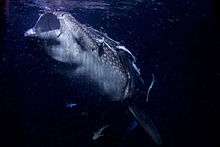
Coastal forecast area
Ningaloo Coast is a designated weather forecast area, by the Bureau of Meteorology.[15]
See also
- Protected areas of Western Australia
- Gnaraloo
- Gnaraloo Turtle Conservation Program
- Ningaloo Station
- Warroora
References
- "Ningaloo National Marine Park, Western Australia". NASA Earth Observatory. NASA. Archived from the original on 20 January 2009. Retrieved 7 September 2008.
- "Ningaloo Coast". World Heritage List. UNESCO. 2014. Archived from the original on 3 September 2014. Retrieved 30 August 2014.
- "Ningaloo Reef – Traditional Owners". Ningaloo Whaleshark Swim. 2013. Archived from the original on 19 December 2013. Retrieved 18 December 2013.
- "Ningaloo Indigenous Heritage Western Australia". Whale shark tours. Kings Ningaloo Reef Tours. 2012. Archived from the original on 2 March 2014. Retrieved 30 August 2014.
- "Natural Properties – Ningaloo Coast (Australia)". Committee Decisions. UNESCO World Heritage Convention. 2011. Archived from the original on 3 September 2014. Retrieved 30 August 2014.
- "Ningaloo Coast gets world heritage listing". ABC News. Australia. 25 June 2011. Archived from the original on 27 June 2011. Retrieved 25 June 2011.
- "Inclusion of a place in the National Heritage List: Ningaloo Coast" (PDF). Special government gazette (PDF). Department of the Environment, Commonwealth of Australia. 6 January 2010. Archived (PDF) from the original on 3 September 2014. Retrieved 30 August 2014.
- Bright, M. (2005). 1001 natural wonders you must see before you die. London: Quintet Publishing.
- "Ningaloo revealed". Australian Geographic. Archived from the original on 5 October 2009. Retrieved 9 June 2009.
- "Sea snake thought to be extinct 'rediscovered' in Western Australia". Guardian Australia. 22 December 2015. Archived from the original on 22 December 2015. Retrieved 22 December 2015.
- "Tim Winton's Ningaloo Reef Rally Speech". The Wilderness Society. Archived from the original on 8 October 2006. Retrieved 19 December 2006.
- "Tim Winton wins WA Premier's Award and donates all proceeds to save Ningaloo Reef". The Wilderness Society. Archived from the original on 8 October 2006. Retrieved 19 December 2006.
- Western Australia. Department of Conservation and Land Management; Western Australia. National Parks and Nature Conservation Authority; Exmouth (W.A. : Shire). Council; Western Australia. Dept. of Conservation and Land Management; Exmouth (W.A. : Shire) (1998), Jurabi and Bundegi Coastal Parks, and Muiron Islands : draft management plan 1998, The Dept, retrieved 26 July 2020
- Source: (2005) Ningaloo Marine Park sanctuary zones and Muiron Islands marine management areas [cartographic material] Perth, W.A.: Dept. of Conservation and Land Management. Scales vary ; Mercator proj. (E 113°24'--E 114°25'/S 21°38'--S 23°59'). Geocentric Datum of Australia 1994 (GDA94)
- "Archived copy". Archived from the original on 21 April 2017. Retrieved 20 April 2017.CS1 maint: archived copy as title (link) Western Australia Forecast Areas
External links
| Wikimedia Commons has media related to Ningaloo Reef. |
- Official websites
- UNESCO World Heritage List: Shark Bay, Western Australia
- "National Heritage Places – The Ningaloo Coast". Department of the Environment. Australian Government.
- "The Ningaloo Coast, Ningaloo Rd, Ningaloo, WA, Australia". Australian National Heritage Database. Department of the Environment, Australian Government. 1 January 2010.
- "World Heritage Nomination: IUCN Technical Evaluation: Ningaloo Coast (Australia)" (PDF). World Heritage Convention (PDF). UNESCO. May 2011.
- Additional information